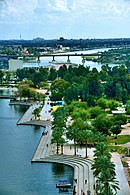Ghazaliya
Ghazaliya (Arabic: الغزالية) is a neighborhood in the western outskirts of Baghdad, Iraq, in the city's Mansour district. To the north of Ghazaliya is the neighborhood of Al-Shu'ala, to the east is Al-Adel, to the south is Al Khadhraa, and to the west is Abu Ghraib. It is a working-class neighborhood of about 100,000 residents.[1] Ghazaliya is situated around six major streets that all end at farms that formerly belonged to Uday Hussein, the son of Saddam Hussein.
Etymology
It is believed to be named after the name of woman she was with her sister the owners of the land her name was Ghazaliya she was owning half of the land. Her sister named Junyina and she was owning the other half of the land. Till 1990's the name of the city was Ghazaliya and Junyina. Then became Ghazaliya name called on both lands.
History
This section needs additional citations for verification. (July 2014) |
Ghazaliya was built in the Mid-1980s and was home for many military officers during Saddam Hussein's rule.[1][2] It was a middle to high class area of mainly Sunni Muslims with some Shia,[2] Christians and others. Saddam hid here during the first Gulf War.[2]
When Sunni–Shia conflict flared in Irag following the February 2006 al-Askari Mosque bombing in Samarra, Shia militias pushed into Ghazaliya from neighboring Al-Shu'ala. Sunnis turned to Al-Qaeda in Iraq and Shia families fled. Ghazaliya's mixed community split into a Sunni southern section and a Shia northern section. The US Army built concrete walls to segregate the two communities and to create a secure perimeter.[2][1]
References
- ^ a b c McDonnell, Patrick J. (8 July 2014). "Iraq militants' advance casts shadow over Baghdad neighborhood". Los Angeles Times. Retrieved 15 August 2014.
- ^ a b c d Anderson, Jon Lee (19 November 2007). "Inside the surge". The New Yorker. Retrieved 15 August 2014.

